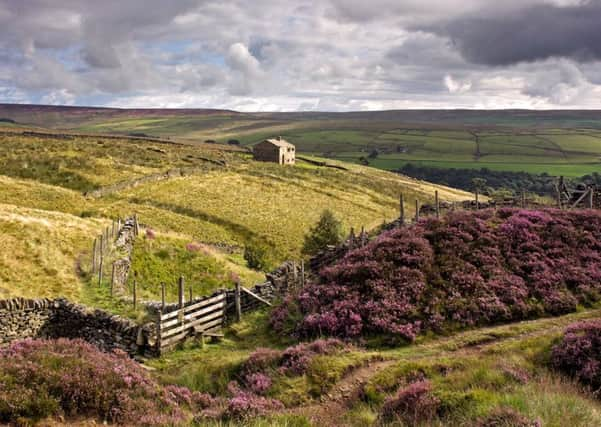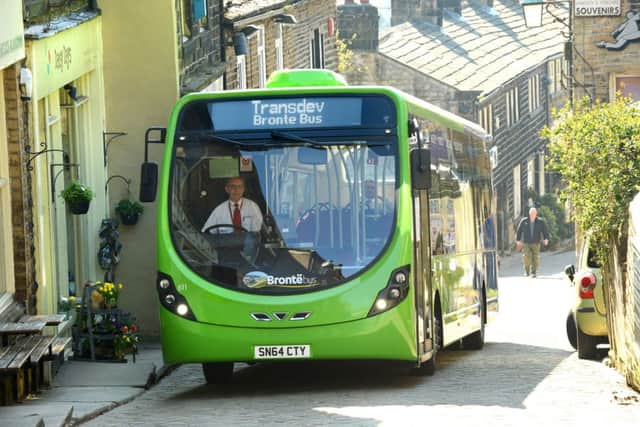Exploring Brontë country from the back seat of a bus


Moments before the Brontë Bus pulls out of Haworth, an elderly man gets on and recognises a friend sitting near the back. “Nar then,” he says, and sits down next to him. “All reight?” The friend nods. “All reight,” he says, gravely. “You all reight?” The man nods. “All reight,” he says, also gravely. The conversation lapses.
It’s not quite Jane Eyre, but we’ll work on it.
The Brontë Bus, since you ask, is a regular daily service between Keighley and Hebden Bridge via Haworth, the capital of the semi-mythical kingdom of Brontetania. Launched last year by Transdev in Keighley, Service No 500, as it’s officially called, is one of the highest bus routes in the Pennines. It links two of Yorkshire’s prime tourist towns and covers the dozen miles between them in about 45 minutes. On the way, it climbs to 1,400ft, offering top-of-the-world moorland views and an insight into the wild landscapes that inspired the Brontës.


Advertisement
Hide AdAdvertisement
Hide AdI came across it by chance a couple of months ago. Heading home from Hebden Bridge, I found a smart, bright green bus standing in the station car park. Intriguingly, it said “Brontë Bus” on the front. Was it a tour bus? Was it a heritage run, with drivers kitted out in Victorian top hats or bonnets? The driver explained and – well, reader, I couldn’t resist.
Going home could wait. I climbed aboard and discovered not so much a bus as a cabaret. In one of the front seats a jovial old chap from Keighley was saying he’d just been to Burnley for lunch. He was clearly a regular passenger and seemed to know everyone on the bus – and he knew the route as well as the driver. “When you get t’t’bottom of t’next street, give it a wide berth where there’s t’house that used to be t’old Post Office,” he advised as we neared Oxenhope.
He waved t’t’driver – sorry, to the driver – of every oncoming bus. “Harvey’s driving today,” he said. “I know ’em all.” Momentary pause. “Next bus up this road will be Stanbury.” Then he launched into a chorus of Popeye the Sailor Man.
I rather miss him when I return to Hebden Bridge a few weeks later to do the trip again, armed with my battered 1906 copy of the Thorough Guide to Yorkshire. On a day of unexpected warm spring sunshine, the journey is a joy. About two dozen passengers pile on in Hebden town centre (in an orderly West Riding way) – hikers with rucksacks, shoppers with heavy bags, a young woman with a pram, another young woman absorbed in the Elsewhere world of her iPhone.


Advertisement
Hide AdAdvertisement
Hide AdWith Geoff Bartlett, 16 years a driver, at the wheel, we climb steeply out of town, the tall stone houses stacked high up the hillsides below us. “Long hills but good road,” noted MJB Baddeley, BA, author of the Thorough Guide. We climb higher and higher, and course across open moors, past Clattering Edge and Bedlam Hill, past Gib Slack and Bare Clough Head. In the distance, Heptonstall clusters on its hilltop like an Italian hill town with a cloth cap.
We round a bend and the whole of Yorkshire seems to unfold on the left. A wutheringly bleak landscape stretches out, dotted with farms and sheep and stone walls. The ramblers get off in the middle of nowhere, passengers disappear down narrow farm drives with their shopping, the Elsewhere girl is still Elsewhere.
Everyone else is gripped by the exhilarating view, the Here and Now. For the sake of completeness, I carry on to Keighley, then get the next bus back to Haworth. MJB Baddeley, BA, had a thing or two to say about the village in 1906. Readers of the Brontë novels and Mrs Gaskell’s biography of Charlotte, he suggested, might be surprised: “It is not specially gloomy, and the buildings associated with the sisters’ memory are no longer as they were in their time.”
The church exterior was “singularly ugly” and the parsonage was “open to all introduced visitors, the thousands of others being necessarily excluded”. These days, of course, the thousands of others are welcomed with open arms and open shop doors. I doubt Mr Baddeley would be too impressed by the steep main street today. With every passing year, it gets ever more bijou: a fiesta of chintzy chic, vintage, retro and Brontë bric-a-brac-ery (though there are a couple of excellent second-hand bookshops flying the flag for literature).
Advertisement
Hide AdAdvertisement
Hide AdThe best time to go is in winter, staying overnight. The village can feel deserted and a moorland path beckons you to Top Withens, the possible inspiration for the Earnshaw home in Wuthering Heights. In the evenings the street lights gleam on the cobbles up to the parsonage. It becomes what visitors hope it will be: “atmospheric”.
Haworth re-sampled, I catch the next Brontë Bus back to Hebden Bridge. Seen this way round, the landscape is even more panoramically stirring. I spot Brontë businesses everywhere, with the prize for enterprise going to Brontë Seamless Aluminium Guttering. It’s been a glorious day-out; rather better than all-reight.
For information about the Brontë Bus phone 01535 603284 or go keighleybus.co.uk.